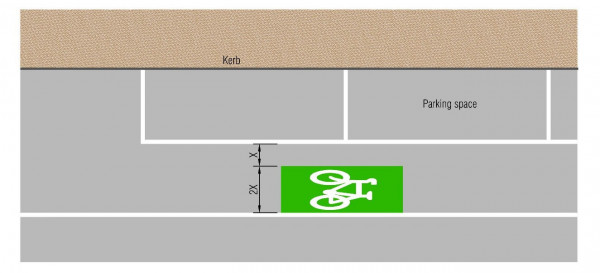Cycle lanes next to the kerb or road edge should be implemented in accordance with Table 8‑9 and its associated notes.
The widths of cycle lanes in Table 8‑9 should be measured from the usable point, which could be the kerb face (where there is no vertical lip (>5mm) formed between the roadway and the fender) or the edge of a dish channel. An allowance also needs to be made where ramps have been provided at vehicle access ways, or sumps extend into the cycle lane. It also assumes that surface conditions adjacent to the gutter or road edge are of a high standard. Where there are poor surface conditions at the road edge, the widths of cycle lanes should be based on usable road space available to cyclists.
While not required by the TCD rule, it is best practice to mark a no-stopping line along the length of a kerbside lane to prevent parking. This is because of ongoing difficulties with illegal parking and the difficulties experienced enforcing it. Experience from all the main centres is now that the cost of the markings is justified and reduces the safety risk from cars parking in the cycle lane.
Table 8‑9: Cycle lane widths next to kerb or road edge or between traffic lanes
| Cycle lane widths | |||
|---|---|---|---|
| Speed Limit (km/h) | <50 | 70 | 100 |
| Desirable width (m) | ≥1.6 | ≥1.9 | ≥2.5 |
When using Table 8‑9, the following key width requirements of cycle lanes where no parking exists, are:
Where the combined width of a cycle lane and parking space is limited, the parking space should be kept narrow, so that good parking discipline is encouraged, allowing cyclists to avoid open car doors.
A parking space width of 2.0m should only be used if parked cars can easily park up against the kerb, with 1.9m the absolute minimum width as per Table 8‑10. Wider parking lanes should be provided on roads with steep camber, or on curved sections (where parking next to the kerb is difficult), where there is excess road space available or where heavy vehicle parking is common.
Table 8‑10: Cycle lane widths next to parallel parking
| Facility width | ||
|---|---|---|
| Speed limit (km/h) | <50 | ≥70 |
| Minimum width cycle lane (m) | 1.8 | 2.0 |
| Minimum width parking (m) | 1.9 | 1.9 |
| Desirable overall facility width (m) | ≥4.0 | ≥4.5 |
| Acceptable range of overall facility width (m) | 3.7-4.5 | 3.9-4.7 |
Table 8-10 notes:
Figure 8‑11 illustrates a typical configuration of a cycle lane next to parallel parking. The cycle symbol and coloured background road surface should be placed in the two-thirds of the cycle lane furthest from the parked cars. This will encourage cyclists to avoid the hazard posed by car doors being opened.
Figure 8‑11: Cycle lane next to parallel parking

View larger image [JPG, 120 KB]
People require a high level of protection when cycling adjacent to angle parking, and therefore when implementing angle parking, the needs of cyclists should be given appropriate consideration.
Cycle lanes should be a suitable distance away from angle parking to encourage cycling in a position that aids visibility between drivers and cyclists and allows cyclists to avoid vehicles that are emerging from a car parking space.
Angle parking is appropriate only where the speed limit is 50km/h or less. Cycle lanes next to angle parking assist in reminding drivers of the potential presence of cyclists. Cycle lanes adjacent to angle parking should be installed in accordance with the clearance details shown in Table 8‑11 and the associated typical facility layout illustrated in Figure 8‑7. Minimum widths should only be used in low speed environments (85th percentile speed of 40km/h and below) and when it is not possible to achieve a wider cycle lane.
Lanes should be coloured green and marked with standard cycle symbols to enhance their visibility.
Table 8‑11: Cycle lane clearance from angle parking
| Clear space between parked vehicles and cycle lanes | |||
|---|---|---|---|
| Parking angle (degrees) | 45 | 60 | 90 |
| Desirable clearance (m) | 2.0 | 2.5 | 3.0 |
| Minimum clearance (m) | 1.5 | 2.0 | 2.5 |
Table 8‑11 notes:
For guidance on how to mark cycle lanes at bus stops, refer to cycle lanes at bus stops.